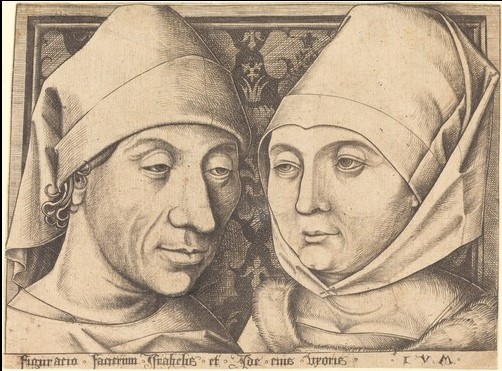Jan 18, 2022
In s2e11, Tru Ludwig and Ann Shafer talk about chiaroscuro woodcuts before moving on to the Mannerist painter and printmaker Parmigianino. Coming off the High Renaissance and the Sack of Rome in 1527, artists were looking for ways to shake it up. Out goes the solid forms and placid emotions and in comes the twisting, off-kilter compositions and extremes in emotions. Parmigianino is the first to really take up etching in a meaningful way (it's been engraving until this point--remember, Dürer tried etching but hated it). Tru makes the case for Parmigianino as a crucial creator. Ann becomes a fan.
Episode image: Parmigianino (Italian, 1503–1540). Entombment, c. 1527–30. Etching. Sheet: 13 1/16 x 9 7/16 in. (332 x 240 mm.). Metropolitan Museum of Art, New York.
Israhel van Meckenem (German, c. 1445–1503). Double Portrait of
Israhel van Meckenem and His Wife Ida, c. 1490. Engraving.
Sheet (trimmed to platemark): 130 x 175 mm. (5 1/8 x 6 7/8 in.).
National Gallery of Art, Washington, D.C.
Raphael (Italian, 1483–1520). School of Athens, 1509–11.
Stanza della Segnatura, Apostolic Palace, Vatican.
Michelangelo (Italian, 1475–1564). Sistine Chapel Ceiling,
1509–12. Vatican.
Parmigianino (Italian, 1503–1540). Madonna and Child with
Angels (Madonna with the Long Neck), c. 1534–40. Oil on panel.
216.5 x 132.5 cm. Uffizi Gallery, Florence.
Parmigianino (Italian, 1503–1540). Self-Portrait in a Convex
Mirror, c. 1524. Oil on convex panel. 24.4 cm. diameter.
Kunsthistoriches Museum, Vienna.
Giovanni Jacopo Caraglio (Italian, c. 1500/05–1565).
Diogenes, c. 1526–27. Engraving. Sheet (trimmed within
platemark): 286 x 217 mm. (11 ¼ x 8 9/16 in.). Metropolitan Museum
of Art, New York.
Michelangelo (Italian, 1475–1564). Madonna of the Stairs,
c. 1491. Marble. 56.7 cm × 40.1 cm (22.3 in
× 15.8 in). Casa Buonarroti, Florence.
Michelangelo (Italian, 1475–1564). Pietà, 1498–99. Marble.
174 × 195 cm (68.5 × 76.8 in). St. Peter’s
Basilica, Vatican City.
Ugo da Carpi (Italian, c. 1470–1532), after Parmigianino (Italian,
1503–1540). Diogenes, c. 1527–30. Chiaroscuro woodcut
printed from four blocks in gray-green. Image: 18 11/16 x 13 5/8
in. (475 x 346 mm.). Metropolitan Museum of Art, New York.
Roman. Laocoön and His Sons, 27 BCE–68 CE. Marble. 208
× 163 × 112 cm. (82 × 64 × 44 in.).
Museo Pio-Clementino, Vatican City.
Lucas Cranach the Elder (Germany, 1472–1553). Saint
Christopher, c. 1509. Chiaroscuro woodcut printed in black and
red-brown. Image: 11 x 7 1/2 in. (279 x 191 mm.). Minneapolis
Institute of Arts, Minneapolis.
Ugo da Carpi (Italian, c. 1470–1532), after Titian (Italian,
1489/90–1576). St Jerome in the desert seated facing left,
c.1516. Chiaroscuro woodcut with two color blocks in green. Sheet:
156 x 95 mm. British Museum, London.
Antonio da Trento (Italian, c. 1508–1550), after Parmigianino
(Italian, 1503–1540). The Martyrdom of Saints Peter and
Paul, c. 1530. Chiaroscuro woodcut printed from three blocks
in three tones of blue. Sheet: 28.3 x 47 cm. (11 1/8 x 18 1/2 in.).
National Gallery of Art, Washington, D.C.
Antonio da Trento (Italian, c. 1508–1550), after Parmigianino
(Italian, 1503–1540). The Martyrdom of Saints Peter and
Paul, c. 1530. Chiaroscuro woodcut printed from three blocks
in ochre and black. Sheet: 29 x 48.2 cm (11 7/16 x 19 in.).
National Gallery of Art, Washington, D.C.
Antonio da Trento (Italian, c. 1508–1550), after Parmigianino
(Italian, 1503–1540). The Martyrdom of Saints Peter and
Paul, c. 1530. Chiaroscuro woodcut printed from three blocks
in dark green (line block), gray-green, and light gray-brown. Sheet
(trimmed within border): 28.5 x 46 cm (11 1/4 x 18 1/8 in.).
National Gallery of Art, Washington, D.C.
Parmigianino (Italian, 1503–1540). Entombment, c. 1527–30.
Etching. Sheet: 13 1/16 x 9 7/16 in. (332 x 240 mm.). Metropolitan
Museum of Art, New York.
Albrecht Dürer (German, 1471–1528). Agony in the Garden,
1515. Etching. Sheet: 9 3/16 × 6 9/16 in. (234 × 166 mm.).
Metropolitan Museum of Art, New York.
Parmigianino (Italian, 1503–1540). The Lovers, 1527–30.
Etching. Sheet (trimmed within platemark): 5 13/16 × 4 1/8 in. (148
× 105 mm.). Metropolitan Museum of Art, New York.
Andrea Mantegna (Italian, 1430/31–1506). The Entombment of
Christ, before 1475. Engraving and drypoint. Plate: 11 7/16 x
16 3/8 in. (290 x 416 mm.). Metropolitan Museum of Art, New
York.
Federico Barocci (Italian, 1528–1612). The Stigmatization of
Saint Francis, c. 1575. Etching, engraving, and drypoint.
Sheet (trimmed to platemark): 228 x 145 mm. Achenbach Foundation
for Graphic Arts, Fine Arts Museums of San Francisco.
FURTHER READING
Naoko Takahatake, ed. The Chiaroscuro Woodcut in Renaissance Italy. Los Angeles: Los Angeles County Museum of Art, and Munich and New York: DelMonico Books/Prestel, 2018.
David Rosand. Titian and the Venetian Woodcuts: A Loan Exhibition. Washington, D.C.: International Exhibitions Foundation, 1976.
Rinaldo Canalis and Massimo Ciavolella, eds. Andreas Vesalius and the Fabrica in the Age of Printing: Art, Anatomy and Printing in the Italian Renaissance. Turnhout, Belgium: Brepols, 2018.
Larry Silver and Elizabeth Wyckoff, eds. Grand Scale: Monumental Prints in the Age of Dürer and Titan. Wellesley, MA: Davis Museum and Cultural Center, Wellesley College, in association with Yale University Press, New Haven, 2008.
Linda Hults. The Print in the Western World: An Introductory History. Madison, WI: University of Wisconsin Press, 1996.




















